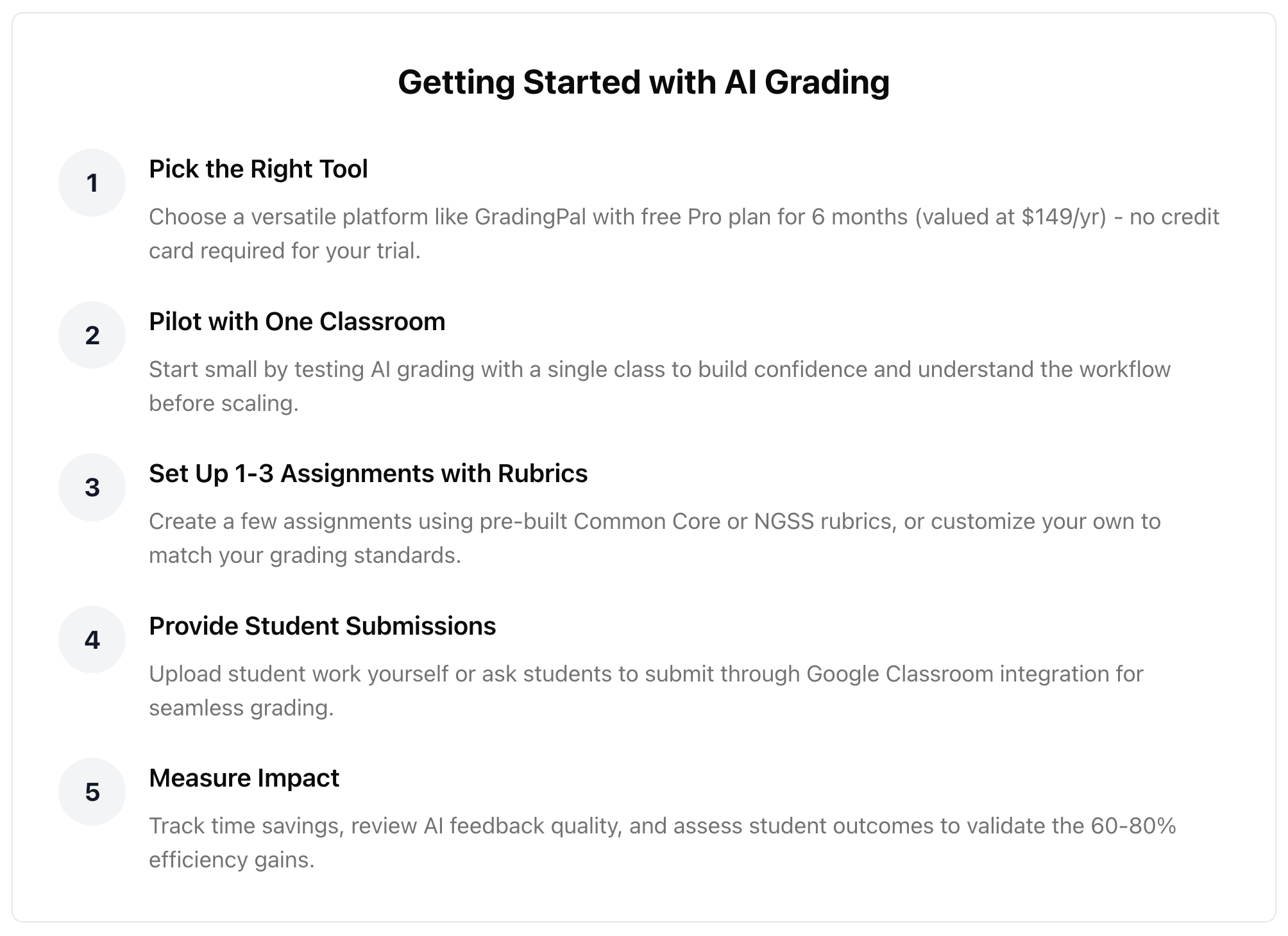How AI Grading Saves K-12 Teachers 60-80% Time on Math Worksheets and Essays
K-12 teachers in the USA spend an average of 10-15 hours per week on grading alone, according to a 2025 Coursebox report. For many, that time is consumed by repetitive tasks like scoring math worksheets or providing feedback on essays - leaving little room for creative instruction or student interaction. But what if AI could handle 60-80% of that workload?
Table of Contents
- 1. The Time Trap of Traditional Grading in K-12 Classrooms
- 2. How AI Automates Rubric-Based Scoring for Math Worksheets
- 3. Streamlining Essay Grading with AI Tools: From Rubrics to Actionable Feedback
- 4. Real Teacher Stories: 60-80% Time Savings in Action
- 5. Getting Started with AI Grading: Tips for K-12 Teachers
The Time Trap of Traditional Grading in K-12 Classrooms
Traditional grading is a relentless cycle for K-12 teachers. Imagine a 5th-grade math teacher facing 30 multiplication worksheets: scanning for errors, calculating partial credit, and noting patterns like skipped steps in borrowing. Or a 9th-grade ELA instructor reviewing 25 argumentative essays, checking thesis strength, evidence, and grammar against rubrics aligned with Common Core standards. A 2025 MentalUP study found that these tasks account for 70% of teachers' non-instructional time, contributing to burnout rates as high as 44% among U.S. educators.
The problem isn't just volume - it's the manual nature. Handwritten math worksheets require OCR-like precision to avoid errors, while essays demand nuanced feedback like "Strong claim, but add counterarguments for depth." Without AI grading tools, teachers juggle this alongside lesson planning, parent communications, and IEPs, often sacrificing personal time. Enter AI grading: it automates rubric-based scoring, providing consistent, standards-aligned results while generating actionable feedback. Platforms like GradingPal integrate seamlessly with Google Classroom, ensuring FERPA-compliant data security. The result? Teachers reclaim 60-80% of their grading time, per Coursebox benchmarks, allowing focus on differentiated instruction and student relationships.
This shift isn't futuristic - it's happening now in classrooms nationwide. With AI, grading becomes a tool for empowerment, not exhaustion. Let's dive into how it specifically tackles math worksheets and essays, two of the most time-intensive K-12 assignments.

How AI Automates Rubric-Based Scoring for Math Worksheets
Math worksheets are a staple in K-12 curricula, from kindergarten number tracing to high school algebra proofs. Yet, grading them manually - verifying calculations, checking work shown, and aligning with Common Core standards - can take 2-3 hours per class set. AI grading tools change that by leveraging optical character recognition (OCR) and machine learning to scan, score, and analyze in seconds.
Take GradingPal's approach: Upload a stack of 3rd-grade multiplication worksheets, and its AI uses OCR to extract handwritten answers, applying a customizable rubric for accuracy (e.g., 80% for correct products, 20% for steps). The tool instantly flags errors like skipped carrying, generating feedback such as "Great job on the 4s table - double-check borrowing in problem 5." This not only scores but identifies class trends, like 40% struggling with multi-digit multiplication, for targeted reteaching.
For middle school geometry, GradingPal evaluates problem sets with NGSS-aligned rubrics, commenting on theorem application: "Correct Pythagoras use - verify side lengths for precision." Teachers save 60-80% time, per 2025 Coursebox data, redirecting energy to hands-on activities. Unlike traditional methods, AI ensures consistency, reducing bias in partial credit. Plus, with GradingPal's free Pro plan (valued at $19/mo or $149/yr), you get unlimited uploads for 6 months - no credit card needed. Explore GradingPal's OCR for math worksheets.
Streamlining Essay Grading with AI Tools: From Rubrics to Actionable Feedback
Essays, a cornerstone of K-12 ELA and social studies, demand even more time - up to 4 hours per set for feedback on structure, evidence, and voice. AI grading tools like GradingPal automate this with natural language processing (NLP), analyzing text against rubrics to deliver nuanced, standards-aligned scores.
For a 10th-grade argumentative essay on climate change, GradingPal evaluates thesis (30%), evidence (40%), and organization (30%), scoring and suggesting: "Strong claim on renewable energy - add two counterarguments with rebuttals for depth." This rubric-based approach aligns with Common Core's emphasis on argument writing, ensuring feedback is specific and growth-oriented. Teachers can customize rubrics for AP-level essays, incorporating NGSS cross-curricular elements like data interpretation.
The real magic? AI generates personalized comments at scale, identifying trends like weak transitions across the class for mini-lessons. A 2025 MentalUP survey showed 75% of teachers using AI for essays reported improved student revisions. GradingPal's integration with Canvas or Google Classroom pushes feedback directly to students, fostering ownership. With the free Pro plan (valued at $19/mo), unlimited essay grading is yours for 6 months - perfect for testing without commitment. See essay grading examples.

Real Teacher Stories: 60-80% Time Savings in Action
To see AI grading's impact, let's hear from K-12 educators using GradingPal.
Ms. Rodriguez, a 7th-grade math teacher in Arizona, previously spent 3 hours weekly on algebra worksheets. "With GradingPal's OCR, I grade a class set in 20 minutes," she says. "The feedback like 'Verify your variables' helps students self-correct, and analytics showed 60% improvement in equation solving." This aligns with Coursebox's 2025 findings on AI-driven reteaching.
Dr. Carter, an 11th-grade ELA teacher in Virginia, tackled 40 AP essays. "Rubric-based AI scoring cut my time from 6 hours to 1.5," she shares. "Comments like 'Strengthen evidence with quotes' are spot-on, and the free Pro plan made it risk-free." Her class revision rate rose 35%.
These stories reflect GradingPal's 97% satisfaction rate (MentalUP, 2025). From elementary fraction sheets to high school argumentative pieces, AI grading saves 60-80% time, per benchmarks, letting teachers prioritize relationships and creativity. Explore teacher use cases.

Getting Started with AI Grading: Tips for K-12 Teachers
Ready to reclaim your time? Here's how to integrate AI grading seamlessly.
- Choose the Right Tool: Opt for versatile platforms like GradingPal, supporting math worksheets and essays with OCR and rubrics. Avoid essay-only tools for multi-subject needs.
- Set Up Rubrics: Start with pre-built Common Core templates, customizing for your class (e.g., 20% for steps in math worksheets).
- Pilot with Free Access: Use GradingPal's free Pro plan (valued at $19/mo or $149/yr) for 6 months to experience unlimited testing - no credit card required.
- Train and Iterate: Share AI feedback with students for ownership; use analytics to refine lessons.
- Measure Impact: Track time savings and student outcomes - expect 60-80% efficiency gains, as in Coursebox studies.
AI grading isn't about replacing teachers; it's about amplifying their impact. With tools like GradingPal, K-12 classrooms become more equitable and engaging.

Ready to Save 60-80% Grading Time?
Start with our free Pro plan for 6 months - unlimited uploads, no commitment.
No credit card required • Free for US teachers • Set up in minutes